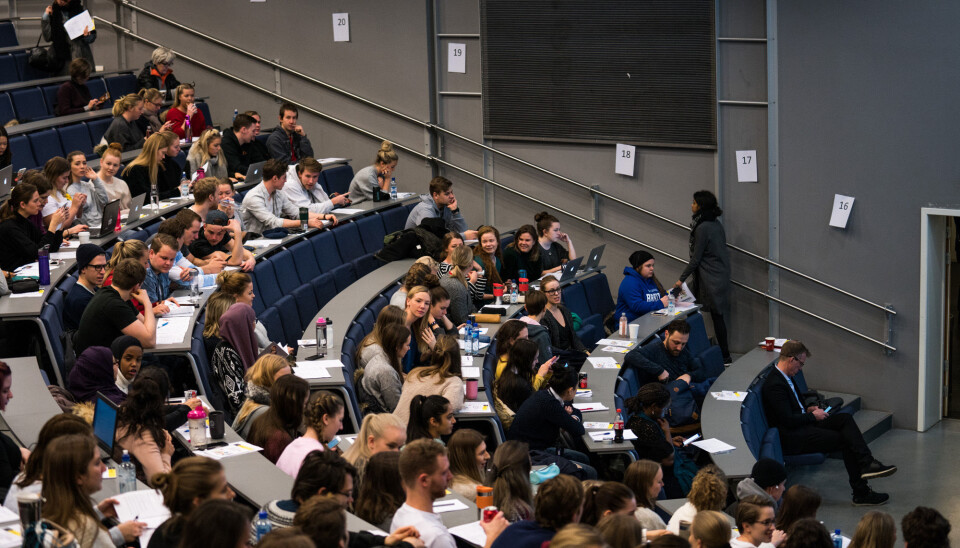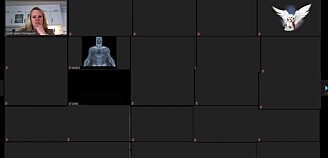Har du lest disse?
Siste fra forsiden:
Kortnytt
Dette Lucia-toget gleda høgskulen

Desse gleda studentar og tilsette ved Høgskulen i Volda fredag. Framme: høgskuledirektør Oddrun Rangsæter og rektor Odd Helge Mjellem Tonheim. privat Med rektor Odd Helge Tonheim i spissen gjekk det eit Lucia-tog gjennom Høgskulen i Volda sine ulike bygg fredag 12. desember. 150 lussekattar, ein kasse mandarinar og ein god del twist gjekk med. Tilbake fekk toget, med rektor, høgskuledirektør og representantar for velferdsgruppa og studentparlamentet, både smil og gode ord.
— Dette har me gjort i fleire år, eg var med også som prorektor, seier Tonheim til Khrono.
— Er det sjølvsagt at det er rektor som skal få bera luciakruna?
— Nei, det har berre vorte slik, seier Tonheim og humrar.
— Men det er fleire som seier at dei likar godt at det er ei mannleg Lucia som kjem.
Og dersom nokon lurte: Brannvernet er teke hand om. Både Lucia og hjelparane har gått over til batterilys.
Ny dekan ved NMBU
Svein Jarle Horn blir ny dekan ved Fakultet for kjemi, bioteknologi og matvitenskap (KBM) ved NMBU i et åremål på fire år.
Horn har vært konstituert dekan siden sommeren, og er nå ansatt av Universitetsstyret, melder universitetet i en pressemelding. Planen var ikke å bli dekan, sier Horn, men etter å ha prøvd seg i rollen syns han det har fungert bra.
— Jeg har et svært godt team rundt meg på KBM, både administrasjonen og forskningsgruppene gjør en glimrende jobb. Jeg synes også samarbeidet med rektoratet og de andre dekanene på NMBU fungerer svært godt. Jeg ser derfor frem til å fortsette i rollen som dekan i 4 år til, sier Horn.
Horn er professor i bioprosessteknologi, og har publisert over 150 forskningsartikler.

Svein J. Horn har vært konstituert dekan ved Fakultet for kjemi, bioteknologi og matvitenskap, og ser fram til fire nye år. Charlotte Bless NTNU-ansatte fikk dobbel lønn
En teknisk feil hos DNB førte til midlertidig lønnsfest for noen NTNU-ansatte.
Kunder hos DNB som får utbetalt lønn i dag 11. desember har fått dobbel utbetaling på grunn av en teknisk feil, melder Adresseavisen. Dette gjelder blant annet ansatte på NTNU, men det er ikke kjent hvor mange. Det er nesten 9000 ansatte ved NTNU.
DNB gjør fremdeles opprydningsarbeid, opplyser pressekontakt Vidar Korsberg Dalsbø i DNB til Adresseavisen.
– Vi beklager til alle våre kunder som ble berørt av feilen. Vi forstår at dette kan ha skapt forvirring, og at noen kanskje følte seg litt ekstra heldige. Vi er veldig lei oss for ulempene det har medført, sier Dalsbø.
Årsaken til problemet var en teknisk feil som gjorde at noen betalinger ble behandlet to ganger i DNB sitt system. Det rammet i hovedsak pensjons- og lønnsutbetalinger fra Nav, men også enkelte andre virksomheter, slik som NTNU.

Gleden er midlertidig for NTNU-ansatte som fikk dobbel lønn 11. desember. DNB jobber med å rette feilen som førte til de høye summene på konto hos flerfoldige DNB-kunder. Ragnhild Vartdal Feiret studiestøtte knyttet til G med muffins og ballonger
Studenter og politikere feiret med både G-ballonger og G-muffins ved Stortinget i dag, at studiestøtten skal knyttes til G i neste statsbudsjett.
Sigve Næss Røtvold, leder av Norsk studentorganisasjon, er svært fornøyd med at studiestøtten skal knyttes til G, som betyr at studiestøtten skal knyttes til grunnbeløpet i folketrygden. Det innebærer i praksis at støtten reguleres i takt med prisveksten.
– Det er en utrolig gledelig nyhet for landets studenter, som i framtiden får en forutsigbar studentøkonomi, sier Røtvold. Han kan også bekrefte at det var gode muffins, av typen sjokolade med smørkrem og marsipanlokk.
Studentene har ønsket seg studielån knyttet til G i flere år. De har kjempet for å knytte den til 1,5 G, men det er ikke kjent hvilken G det blir. Dagens studiestøtte er på 166.959 kroner, mens 1,5 G er 195.900 kroner.

Feiring ved Stortinget at studiestøtten skal knyttes til G. Sigve Næss Røtvold, leder av Norsk studentorganisasjon, og Lise Lyngsnes Randeberg, leder av Akademikerne. Akademikerne/Hanna Hagenes Studentpolitikere og Akademikerne møtte i dag representanter fra SV, MDG, Rødt, Senterpartiet og Arbeiderpartiet for å feire.
– Det her er en seier for studentene! Det er veldig fint å kunne feire det på en hustrig desemberdag sammen med studentorganisasjonene. Dette sikrer at nivået på lån og stipend følger utviklingen, sier Hege Bae Nyeholt (R), som er medlem av Utdannings- og forskningskomiteen på Stortinget.
Å feste studiestøtten til G vil gi studenter en mer forutsigbar økonomi, mener leder av Akademikerne Lise Lyngsnes Randeberg.
– Etter flere års kamp for å knytte studiestøtten til G var det på sin plass å feire gjennomslaget med politikere fra de fem partiene som gjorde det mulig, sier Randeberg.

Feiring ved Stortinget at studiestøtten skal knyttes til G. I midten foran står Lise Lyngsnes Randeberg, leder av Akademikerne, og Sigve Næss Røtvold, leder av Norsk studentorganisasjon. Akademikerne/Hanna Hagenes Fastrentene på studielånet går opp
Alle tre fastrentesatser på studielån øker fra 1. januar.
I perioden 10. til 17. desember kan Lånekassens kunder søke om fast rente på studielånet, melder Lånekassen i en pressemelding.
- 4,726 prosent for tre års bindingstid (opp 0,067 prosentpoeng)
- 4,726 prosent for fem års bindingstid (opp 0,076 prosentpoeng)
- 4,765 prosent for ti års bindingstid (opp 0,077 prosentpoeng)
Fra 1. januar 2026 vil fastrentene på studielån være:
Den flytende renta er fra 1. januar på 4,698 prosent.
Lånekassens renter er basert på gjennomsnittet av de fem beste tilbudene om boliglån i markedet, minus et fratrekk på 0,15 prosent.
– Den enkle forklaringen er at Lånekassens fastrenter går opp fordi markedsrentene for fastrentelån har gått opp. Disse fastrentene er basert på markedsrentene i november, sier Anette Bjerke, kommunikasjonsdirektør i Lånekassen.
47 millioner til forskning for fred i Midtøsten og Nord-Afrika
Forskningsrådet deler nå ut 47 millioner kroner til seks forskningsprosjekter som skal gi ny kunnskap om konflikt, klima og samfunnsutvikling i Midtøsten og Nord-Afrika.
Prosjektene skal, ifølge Forskningsrådet, bidra med ny kunnskap som kan styrke grunnlaget for norsk utenriks- og sikkerhetspolitikk. Mottakerne av midlene er to prosjekter ved Chr. Michelsens Institutt, et ved Universitetet i Oslo (UiO), et ved Institutt for fredsforskning og et ved Norsk utenrikspolitisk institutt (Nupi).
– Forskning og kunnskap er avgjørende for å forstå de komplekse utfordringene og konfliktene i Midtøsten og Nord-Afrika. Kunnskap fra disse prosjektene vil være viktig for norske og internasjonale fagmiljøer som arbeider for fredelig utvikling og bedre livsvilkår i regionen, sier administrerende direktør i Forskningsrådet, Mari Sundli Tveit i en pressemelding.
Til utlysningen kom det inn 24 søknader. Hensikten med utlysningen er å stimulere til forskning av høy kvalitet om Midtøsten og Nord-Afrika.
Prosjektene spenner bredt, fra politiske prosesser til miljøtrusler og flyktningkriser. Prosjektet ved UiO skal undersøke hvilken politisk orden som kan vokse fram i Gaza etter 7. oktober. Et av prosjektene fra Chr. Michelsens institutt ser på grenseoverskridende luftforurensning og vannkonflikter mellom Palestina og Jordan, der giftige partikler fra krigshandlinger forsterker både helsefarer og politiske spenninger.
Minnestund for Anne Husebekk
Tirsdag var det minnestund for tidligere rektor ved UiT Norges arktiske universitet, Anne Husebekk, som gikk bort 5. desember 2025, 69 år gammel.
Minnestunden ble arrangert av UiT. Husebekk skal bisettes fra Tromsø domkirke mandag 15. desember. Hun ble sist vinter rammet av en alvorlig kreftsykdom.

Rektor Dag Rune Olsen talte under minnestunden. Jørn Berger Nyvoll/UiT Husebekk tilbragte det meste av sitt yrkesaktive liv ved UiT Norges arktiske universitet. Hun ble uteksaminert lege fra Universitetet i Tromsø i 1982, og ble senere spesialist og professor i immunologi samme sted.
Khrono intervjuet Husebekk i høst.
— Jeg har en alvorlig diagnose, så jeg er preget av det, men jeg er ikke døende, sa Husebekk da Khrono spurte henne om hvordan helsetilstanden var på det daværende tidspunkt.
— Det var et sjokk å få diagnosen. Det er en aggressiv hjernekreft som det ikke finnes behandling mot, sa Husebekk også.
Nåværende UiT-rektor Dag Rune Olsen talte under minnestunden tirsdag, og viderebringte blant annet følgende ord fra statsråd Sigrun Aasland:
— Anne Husebekk har satt dype spor. Hun var en fremragende akademiker som har bidratt til ny viten, og hun har bragt verden fremover. Hun var en forkjemper for vitenskapens uavhengighet og integritet. Hun var utforskende og ikke redd for å tenke nytt — også på studentenes vegne. Hun hadde en lang karriere ved UiT som forsker og underviser, men ikke minst som innovativ og uredd leder. Hun hadde kompetanse, erfaring og visjoner, og sto støtt også når det stormet.

Anne Husebekk var rektor ved UiT fra 2013 til 2021. Tirsdag var det minnestundt ved UiT i Tromsø. Jørn Berger Nyvoll/UiT Haug fortsetter som styreleder i NUPI
Karl Erik Haug fortsetter som styreleder i Norsk utenrikspolitisk institutt (Nupi) i perioden 2026-2029, melder Kunnskapsdepartementet.
Han er nåværende styreleder for perioden 2022-2025.
Kunnskapsdepartementet oppnevner i tillegg disse til Nupi sitt styre for perioden 1. januar 2026 - 31. desember 2029:
Styremedlemmer
- Teija Tiilikainen, Leder av the European Centre of Excellence for Countering Hybrid Threats
- Laila Susanne Vars, seniorrådgiver i Sametinget
- Simen Bræin, senior visedirektør i Statkraft
- Christian Chramer, direktør i Norges sjømatråd
- Lise Rakner (1. varamedlem), professor i statsvitenskap ved Universitetet i Bergen
- James Jerome John Cameron (2. varamedlem), førsteamanuensis i moderne nordamerikansk historie
Varamedlemmer






